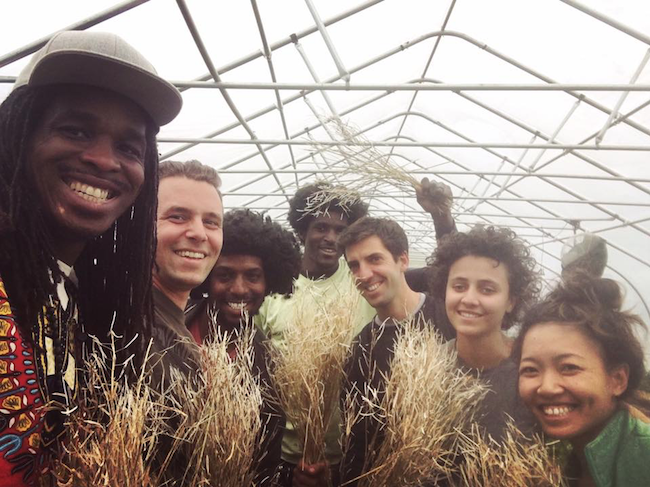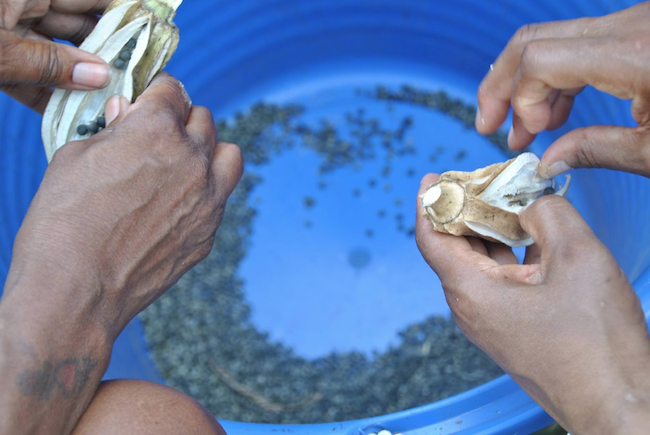
2017 Grantee, Urban Tree Connection – Neighborhood Foods Farm, starting their seed-keeping project.
Starting your own plants from seed can be one of the most satisfying parts of gardening. It’s amazing to watch something that was once just a speck turn into pounds of food under your care. It’s also a great way to save money and will give you access to far more plant varieties than your local gardening center will offer. All you need is some basic knowledge of seed starting, a few supplies, and you can grow your own healthy, productive transplants.
Choosing Varieties
The first step can be one of the hardest. Ordering seeds can be overwhelming because there are so many varieties to choose from. Here’s a few tips to get you started.
- Look at heirloom and open pollinated varieties. These are part of our farming manifesto because these are varieties which farmers and gardeners can save seed from year after year.
- Consider your USDA Agricultural Zone. What your climate is like will determine which varieties will do best in your garden.
- Determine what plants you’d like to grow and have room for before even opening your seed catalog. If you have a plan laid out you can easily limit your purchases to what you’ll actually be able to grow.
- Talk to your neighbors. Do growers in your area struggle with tomato blight? Check out varieties that are more resistant.
Potting Soil and Containers
Once you’ve got your seeds you’ll need to pick up some containers and potting soil. There’s a variety of containers available to purchase and many options as well. The plastic flats are probably the most stream lined and easy to use however peat pots, soil blocks, and homemade newspaper pots are all excellent plastic free options. With these you’ll also obviously need some sort of tray to put them in to hold water.
In selecting potting soil you want to make sure you’ve selected a potting mix not just garden soil. Potting mixes always have something like peat that absorbs and releases moisture over time. You should also look for something that’s been certified organic by the Organic Materials Review Institute or OMRI.
Lights
While it would be awesome if you could just set your plants on a window sill the reality is that you’ll need supplemental light for your plants. Relying on window light not only limits your space but also doesn’t provide the required daily light for your plants to thrive. Unlike your house plants most crops have adapted to having large amounts of light. If you don’t provide overhead light odds are you’ll end up with tall, leggy seedlings that won’t fair well as transplants.
The good news is that you don’t need to spend tons of money on fancy grow lights or kits. Simple fluorescent shop lights will do. You will however need to hang your lights in a way that they can be raised and lowered. Unless you’re using professional grow lights which will come with instructions, lights should be kept no more than a couple inches away from the top of the plant as it grows. You don’t want them to touch the plants though as this can burn the leaves. One of the easiest set ups is to get a wire shelf and hang the lights from chains and hooks that can be shortened as the plants grow.

Saving okra seeds at Urban Tree Connection – Neighborhood Foods Farm.
Basic Care
Keeping up with watering is very important as your seedlings are growing. Small pots can dry out really fast. One of the best methods is to bottom water, meaning you pour the water into the tray your pots are sitting in. You want to keep your plant moist but not soggy so only do this as needed. As some plants prefer a moist environment you can also mist the tops of your plants with a spray bottle to keep them healthy.
You can also incorporate liquid fertilizers into your watering routine as needed. If you notice your seedlings are showing signs of nutrient deficiency like yellowing or pale leaves you can add compost tea, manure tea, or liquid kelp to your water. For compost or manure tea you should use about 1/2 cup per gallon of water. For liquid kelp you’ll probably only need a couple of tablespoons however for purchased mixtures it’s best to follow the instructions on the bottle as they can vary.
Hardening Off
When it’s almost time to plant your garden you’ll need to begin the process of hardening off your seedlings. Even though your seedlings look healthy and vigorous they’re not ready yet to tolerate field conditions. Start bringing your plants outdoors in a sheltered location for just a few hours at a time gradually increasing the time they’re outside over a 7-10 day period. This will slowly adjust them to the sun, wind, and outdoor temperatures. You can also use this period to get them adjusted to less frequent watering. You don’t want to kill them but try letting them dry out a little more than usual each time.
Planting
The best day to plant seedlings out is an overcast one. As they’ll already be dealing with the shock of transplant it’s best they don’t have to cope with full sun on the first day. To give them an extra boost you can dig your holes a little extra deep and mix a bit of compost in with your garden soil at the bottom of each hole. After you’ve planted water them in well. Keeping them moist is especially critical in the first few days after transplant.
An important note if you’re using newspaper, peat pots, or something you bury with the plant, you want to make sure the top of the pot is covered in soil. If it sticks up to much you can cut or tear it off. This is because having it above the soil in the sun and wind will wick water away from the plants roots.
On top of being a lot of fun growing your own transplants increases your connection with your garden and the food you eat. It gives you the freedom to decide what types of seed, potting mix, and containers you’d like to buy and control exactly what goes into your garden and what types of businesses you’re supporting. With a little time and effort you can turn seeds into a bountiful harvest.




